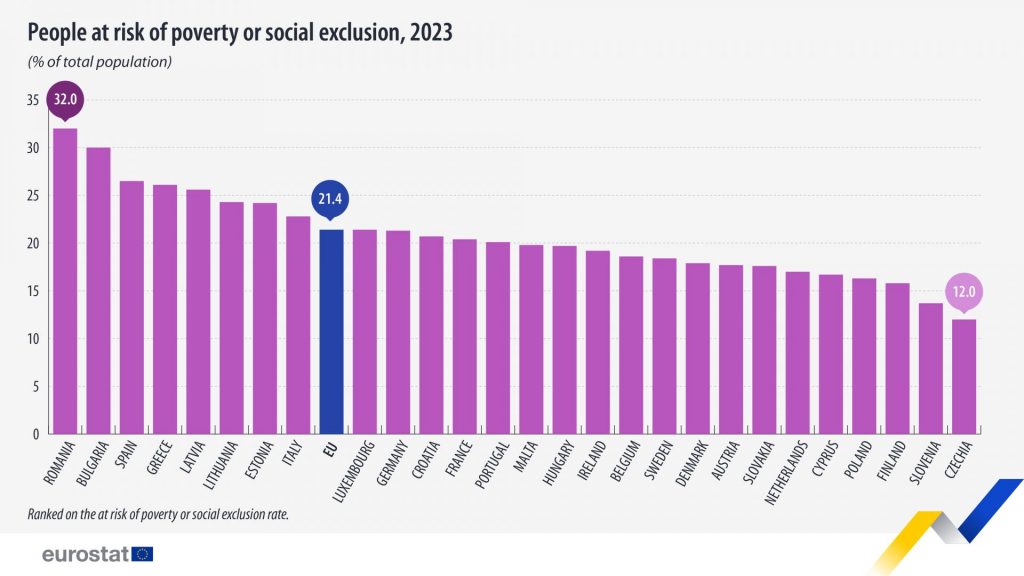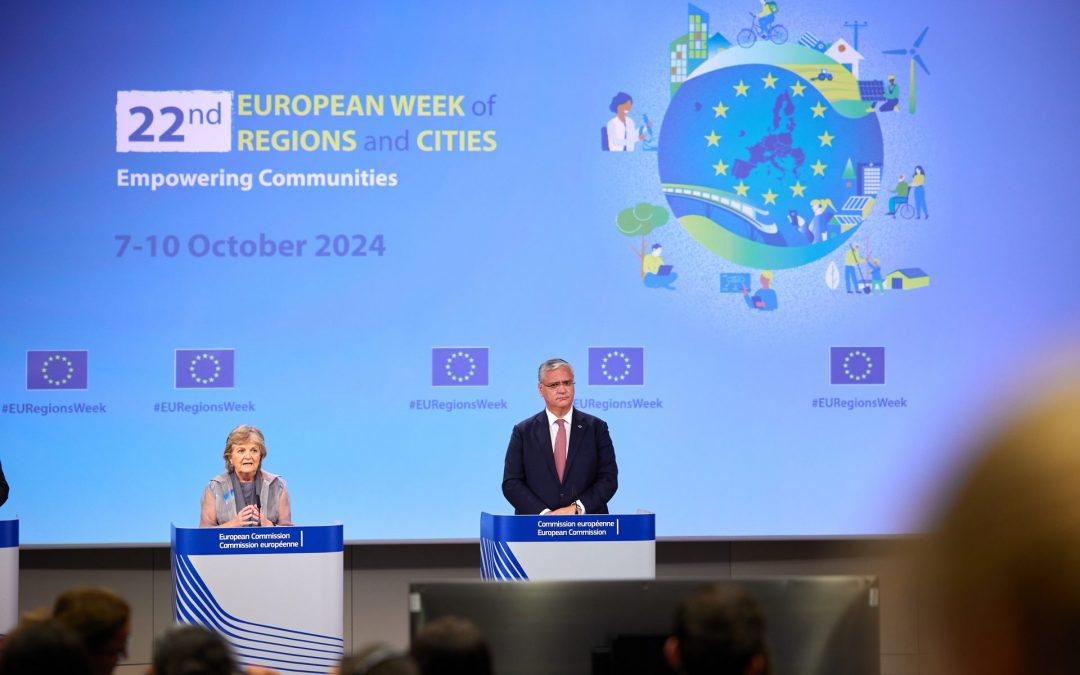 Have the article read by OpenAI (Beta). Please note that AI translations may take some time to process.
Have the article read by OpenAI (Beta). Please note that AI translations may take some time to process.The President of the European Committee of the Regions (CoR), Vasco Alves Cordeiro, warned that “still last year, one hundred million Europeans were at risk of poverty or social exclusion. One in five.”
“We cannot ignore and we cannot accept this,” he said in a speech on Monday opening the 22nd edition of the European Week of Regions and Cities, the largest annual event in Brussels dedicated to Cohesion Policy.
“More than ever, we need cohesion. Not because this is charity, but because for decades, Cohesion Policy has meant progress in Europe. Lifting regions and cities and, with them, lifting people, families, individuals,” the Portuguese politician said.
The CoR is the voice of regions and cities in the EU, representing local and regional authorities across the bloc. It advises on new EU laws that have an impact on regions and cities and is composed of 329 members from the 27 EU member states. Established in 1994, it celebrated its 30th anniversary this year.
Alves Cordeiro also warned of the risk posed to cities and regions in the EU by a possible centralisation at national level of EU Cohesion Policy in the bloc’s next multiannual budget for 2028 to 2034.
“We have been sounding the alarm bell, while some were – or should I say, are – tempted to centralise,” said the CoR president. According to him, this “would abolish the participation of regions and cities”.
The outgoing European Commissioner for Cohesion and Reforms, Elisa Ferreira, expressed a similar opinion, recalling that in July, European Commission President Ursula von der Leyen said in the European Parliament that she was “committed to a strong Cohesion Policy, designed together with regions and local authorities”.
Ferreira had earlier insisted on the importance of “not losing the DNA of Cohesion Policy”, which is “the glue that holds Europe together, and it cannot lose the bottom-up approach”.
Backbone of regional development
EU Cohesion Policy is designed to ensure balanced development across all regions of the bloc’s 27 member states by reducing economic, social, and territorial gaps. It provides funding to support job creation, business competitiveness, economic growth, and sustainable development, particularly in less-developed regions.
By investing in infrastructure, innovation, and social programs, the policy aims to boost regional economies and improve quality of life, ensuring that no region is left behind in the drive toward a more integrated and prosperous EU.
According to European Commission figures, in the last five years Cohesion Policy has supported 2.7 million companies, supported the creation of 260,000 jobs in new companies, and expanded infrastructure and educational facilities for the benefit of some 18 million children and young people. It also supported the participation of at least 12.8 million people in education and training.
Furthermore, it has improved the energy performance of 380,000 homes and the broadband connection of 3.1 million homes.
Albeit outside of the scope of EU Cohesion Policy, the bloc also financially supports regional projects in non-EU countries. In Albania, for example, the EU helps reduce inequality between the country’s regions and assists marginalised communities or those with fewer opportunities in education, social support and cultural activities.
Albania became an official candidate for EU membership in June 2014, and accession negotiations with the country were opened in July 2022.
Initiatives in Albania include strengthening local capacity and running social centres for vulnerable groups (EU4Municipalities), a programme to repair or rebuild more than 60 educational facilities following the devastating earthquake of November 26, 2019 (EU4Schools), and a programme to support the preservation and restoration of clean water sources (EU4Rivers).
Poverty and social exclusion risk remains high for Europeans
A key focus of Cohesion Policy is addressing poverty and social exclusion and to improve living standards and access to opportunities for vulnerable groups. However, millions of Europeans continue to face these challenges today, according to information on the at-risk-of-poverty-or-social-exclusion (AROPE) rate for several European countries.
According to the EU’s statistical office Eurostat, in 2023 about 94.6 million people in the EU were at risk of poverty or social exclusion, equivalent to about 21 percent of the population. The cost-of-living crisis, inflation and the energy crisis, as well as growing housing shortages and the impact of the war in Ukraine are among the reasons for high AROPE rates.

France: In France, according to Eurostat data, 20.4 percent of the population was at risk of poverty or social exclusion. According to an annual report of the charity “Les Petits frères des pauvres” published at the end of September, two million people aged 60 and over are living below the monetary poverty threshold. The threshold is a relative level set at 60 percent of the median income level (i.e. 1,216 Euro per month for a single person and 1,824 Euro for a couple).
Spain: Almost 13 million people are at risk of poverty or social exclusion in Spain, according to the XIV. Report on “The State of Poverty in Spain”, published in June by the European Anti-Poverty Network in Spain (EAPN-ES). According to the study and Eurostat data, the AROPE rate has risen from 26 percent in 2022 to 26.5 percent in 2023 – 400,000 more people, mainly due to the increase in the cost of living.
Romania: Eurostat data shows that the AROPE rate in Romania in 2023 stood at 32 percent of the population – the highest rate in the EU – corresponding to six million people. According to representatives of the Romanian National Trade Union Confederation Cartel Alfa, “almost 80 percent of people with disabilities did not earn enough to afford a vacation, and 35 percent of workers were at the level of the minimum guaranteed wage, which still does not cover the minimum consumption basket for a decent living”.
Bulgaria: According to Eurostat, 30 percent of Bulgarians were at risk of poverty and social exclusion in 2023. In late September, the Bulgarian Council of Ministers set the poverty line for 2025 at BGN 638 (326 Euro), a 21.3 percent increase from where the line stood at this year. Caretaker Labour Social Policy Minister Ivaylo Ivanov said that due to the increase, more individuals and families in need will be covered by state support.
Greece: According to the national statistical service of Greece (ELSTAT) and Eurostat, the population at risk of poverty or social exclusion, based on the data of 2023, amounts to 26.1 percent of the country’s population (more than 2.6 million people), remaining almost unchanged compared to 2022 which was at 26.3 percent. The risk of poverty or social exclusion was the highest for children aged 17 and under (28.1 percent), remaining stable compared to 2022.
Slovenia: Despite having one of the lowest rates of social exclusion in the EU, 13.7 percent of Slovenians (264,000 people) were at risk of poverty in 2023, according to Eurostat data. While housing problems and the cost-of-living crisis are pushing up the proportion of households experiencing financial difficulties, Slovenia is still below the EU average and ranks second behind the Czech Republic, which had an AROPE rate of 12 percent.
North Macedonia: Based on the Survey on Income and Living Conditions, which is carried out in accordance with EU recommendations, the State Statistical Office of North Macedonia calculated that the AROPE rate in 2021 was 23 percent. According to Eurostat, North Macedonia – an EU candidate country since 2005 – had the highest proportion of population at risk of poverty in 2012 of 26.2 percent, but the proportion decreased to 21.8 percent in 2020. However, progress in reducing poverty may have been reversed in 2020 due to the adverse effects of the COVID-19 pandemic.
This article is published twice a week. The content is based on news by agencies participating in the enr.
